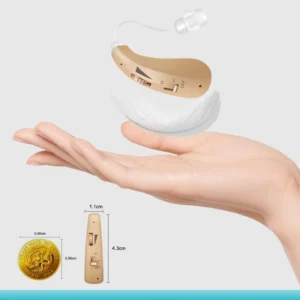An overview of Diplacusis 2024
What is diplacusis?
Diplacusis is a condition where a person perceives the same sound at different pitches in each ear. This auditory distortion can lead to a sensation that the pitch of a sound is altered when heard through one ear compared to the other. It can affect how sounds are heard and processed, making it difficult to accurately perceive pitch and tone.
Types of Diplacusis
- Diplacusis Monophasic: The same sound is perceived at a different pitch in each ear. This can occur if there is a significant difference in hearing thresholds between the two ears or if one ear has a different frequency response.
- Diplacusis Dysharmonica: The sound is perceived as being out of tune or distorted, which can be particularly noticeable with music or complex sounds.
Causes
- Hearing Loss: Differences in hearing sensitivity or frequency response between the two ears.
- Ear Infections: Temporary changes in hearing due to infection or inflammation.
- Fluid in the Ear: Accumulation of fluid in the middle ear can alter sound transmission.
- Acoustic Trauma: Exposure to loud noises that affect auditory perception.
- Neurological Conditions: Central auditory processing disorders or other neurological issues.
Symptoms
- Perceiving the same sound at different pitches in each ear.
- Difficulty with sound localization.
- Distortion of musical pitch or tones.
Diagnosis and Treatment
- Diagnosis: An audiologist or ear specialist will conduct tests to assess hearing sensitivity, frequency response, and potential underlying conditions. This may include a hearing test and possibly imaging studies.
- Treatment: Treatment depends on the underlying cause. It might involve addressing infections, managing hearing loss with hearing aids, or undergoing sound therapy. In some cases, if the diplacusis is due to a persistent issue, managing the condition through regular follow-up and supportive strategies might be necessary.
Is diplacusis a sign of hearing loss?
Diplacusis can be associated with hearing loss, but it is not exclusively a sign of it. Here’s how it relates to hearing loss:
- Hearing Loss: Diplacusis often occurs when there is a difference in hearing sensitivity or frequency perception between the two ears. For example:
- Unilateral Hearing Loss: If one ear has hearing loss while the other does not, the brain may receive sounds differently from each ear, leading to diplacusis.
- Bilateral Hearing Loss: Differences in the degree or type of hearing loss between the two ears can also cause diplacusis.
- Auditory Processing Issues: Even in the absence of significant hearing loss, issues with how the auditory system processes sound can lead to diplacusis. This might include problems with the middle ear or central auditory processing disorders.
- Temporary Factors: Diplacusis can also be caused by temporary conditions such as ear infections or fluid in the middle ear, which might not be related to permanent hearing loss.
- Neurological Factors: In some cases, diplacusis can be linked to neurological issues affecting the auditory pathways or processing centers in the brain, rather than direct hearing loss.
What causes diplacusis?
Diplacusis, the perception of the same sound at different pitches in each ear, can be caused by several factors. Here are some common causes:
- Hearing Loss: Differences in hearing sensitivity between the two ears can lead to diplacusis. For example, if one ear has high-frequency hearing loss and the other does not, sounds may be perceived differently in each ear.
- Ear Infections and Inflammation: Conditions such as ear infections or inflammation can affect how sounds are processed and may cause temporary diplacusis.
- Fluid in the Ear: Fluid buildup in the middle ear (e.g., due to allergies or sinus infections) can alter the way sound is transmitted, leading to diplacusis.
- Acoustic Trauma: Exposure to loud noises can cause damage to the auditory system, which may result in diplacusis.
- Middle Ear Problems: Issues with the middle ear, such as problems with the ossicles (tiny bones in the ear) or the eustachian tube, can affect sound transmission and cause diplacusis.
- Neurological Conditions: Central auditory processing disorders or other neurological issues can interfere with how the brain processes sound, leading to diplacusis.
- Tinnitus: Sometimes, individuals with tinnitus (ringing or buzzing in the ears) may experience diplacusis due to the way tinnitus affects sound perception.
- Genetic Factors: Some people may have congenital or hereditary conditions that affect their auditory processing and lead to diplacusis.
What medications can cause diplacusis?
Certain medications can potentially cause diplacusis as a side effect, primarily through their impact on the auditory system. These medications include:
- Ototoxic Medications: These drugs can damage the inner ear structures or the auditory nerve, leading to auditory distortions like diplacusis. Examples include:
- Aminoglycoside Antibiotics (e.g., gentamicin, streptomycin)
- Loop Diuretics (e.g., furosemide, bumetanide) especially when given in high doses or rapidly.
- Salicylates: High doses of salicylates, such as aspirin, can affect hearing and may lead to temporary auditory distortions, including diplacusis. This is usually reversible once the medication is stopped.
- Chemotherapy Agents: Some chemotherapy drugs, such as cisplatin, have ototoxic effects and can alter auditory perception.
- Certain Antidepressants: In rare cases, medications like tricyclic antidepressants can affect auditory processing.
- Anti-seizure Medications: Some anticonvulsants may have side effects that impact auditory perception, though this is less common.
Is diplacusis permanent?
Diplacusis can be either temporary or permanent, depending on its underlying cause:
- Temporary Diplacusis: If diplacusis is due to a transient issue such as an ear infection, fluid buildup, or temporary changes in hearing, it may resolve on its own once the underlying condition is treated. For example, antibiotics for an infection or decongestants for fluid might alleviate the symptoms.
- Permanent Diplacusis: If the condition is related to more persistent issues, such as permanent hearing loss, structural changes in the ear, or neurological factors, diplacusis might be long-lasting. In such cases, while the diplacusis itself may not be reversible, management strategies can help improve auditory perception and quality of life.
Is diplacusis dangerous?
Diplacusis itself is generally not considered dangerous, but it can be a symptom of an underlying issue that might require attention. Here’s a breakdown of the considerations:
- Underlying Conditions: If diplacusis is caused by an ear infection, fluid buildup, or hearing loss, addressing the underlying condition is important to prevent potential complications, such as hearing damage or chronic infections.
- Impact on Daily Life: While diplacusis may not be dangerous, it can affect quality of life by making it difficult to accurately perceive sounds. This might impact communication, music enjoyment, and overall auditory experience.
- Potential for Misdiagnosis: Sometimes, diplacusis can be a symptom of a more complex auditory or neurological condition. Proper diagnosis is essential to ensure that any serious underlying issues are identified and treated.
- Cognitive and Psychological Effects: For some individuals, the distortion of sound can cause frustration or stress, which can impact mental well-being.
Can diplacusis be cured?
The possibility of curing diplacusis largely depends on its underlying cause. Here’s a general overview:
- Transient Causes: If diplacusis is caused by a temporary condition such as an ear infection or fluid in the ear, treating the underlying issue may resolve the diplacusis. For instance, antibiotics or decongestants might help if an infection or fluid buildup is the culprit.
- Permanent Causes: If the diplacusis is due to more persistent issues like hearing loss, nerve damage, or changes in the ear’s structure, it may not be completely curable. In such cases, management strategies might include hearing aids, sound therapy, or other interventions aimed at improving auditory perception and quality of life.
- Neurological Factors: If the condition is related to neurological issues or central auditory processing disorders, treatment might focus on managing symptoms and improving auditory processing skills through therapy or rehabilitation.
How long does diplacusis last
Diplacusis, which is the condition where a person hears the same sound in two different pitches, can vary in duration depending on the underlying cause. In some cases, it might be temporary and resolve on its own, particularly if it’s related to an ear infection or a transient issue with the auditory system. However, if the cause is something more persistent, such as a neurological issue or structural changes in the ear, the condition might be longer-lasting.
How to treat diplacusis:
Treating diplacusis depends on its underlying cause. Here’s a general approach to addressing the condition:
- Identify the Cause: The first step is to determine what’s causing the diplacusis. Common causes include ear infections, fluid in the ear, hearing loss, and neurological issues. A thorough evaluation by an audiologist or an ENT specialist will help pinpoint the cause.
- Medical Treatment:
- Infections and Inflammation: If an ear infection or inflammation is the cause, antibiotics or anti-inflammatory medications may be prescribed.
- Fluid Accumulation: Decongestants or other medications might be recommended if fluid buildup is causing the issue.
- Hearing Aids and Devices: If hearing loss or changes in the ear’s structure are contributing to diplacusis, hearing aids or other assistive listening devices might help balance sound perception.
- Sound Therapy: For some people, sound therapy can help retrain the brain to process sound more normally, particularly if diplacusis is related to central auditory processing issues.
- Neurological Assessment: If the cause is neurological, treatment might involve working with a specialist who can provide cognitive or auditory training to improve processing abilities.
- Monitoring and Management: In cases where the condition is stable but persistent, regular monitoring and management strategies can help minimize the impact of symptoms.
- Counseling and Support: Sometimes, diplacusis can cause frustration or anxiety. Counseling or support groups can help individuals cope with the psychological aspects of dealing with a chronic condition.
By The Side Concert;
Entrepreneur: “Hello Sharks, my name is Amah, and I’m here to present to you a groundbreaking solution for the millions of people suffering from tinnitus. Tinnitus, as you may know, is a debilitating condition characterized by ringing, buzzing, or other phantom noises in the ears, often with no external source.”

Investors: nodding, indicating understanding
Entrepreneur: “Our product, let’s call it ‘SilenceWave,’ is a wearable device that utilizes advanced neurostimulation technology to effectively suppress tinnitus symptoms. Unlike traditional treatments like masking devices or medications that offer temporary relief, SilenceWave targets the underlying neural mechanisms responsible for tinnitus perception.”
Investors: leaning in with interest
Entrepreneur: “Our device works by delivering precisely calibrated electrical impulses to key regions of the brain associated with tinnitus perception. Through a series of clinical trials, we’ve demonstrated significant reductions in tinnitus severity and improved quality of life for our users.”
Investor: “That sounds promising, but what about safety and usability?”
Entrepreneur: “Great question! Safety is our top priority. SilenceWave is non-invasive and has undergone rigorous testing to ensure it meets the highest safety standards. It’s also designed to be user-friendly, with customizable settings that allow individuals to tailor their treatment experience to their specific needs.”
Investor: “And what’s your market strategy?”
Entrepreneur: “We plan to initially target the millions of individuals suffering from chronic tinnitus who are desperate for relief. Our direct-to-consumer model will allow us to reach these customers efficiently through online channels and strategic partnerships with healthcare providers. In the long term, we see opportunities to expand into other markets, such as hearing loss and cognitive enhancement.”
Investor: “What are you looking for from us today?”
Entrepreneur: “We’re seeking a $1 million investment in exchange for a 10% equity stake in our company. With your expertise and support, we believe we can accelerate our growth and bring relief to even more tinnitus sufferers around the world.”
Investor: “Thank you for your pitch. We’ll discuss and get back to you shortly.”

Introduction: The entrepreneur introduces themselves and the problem they’re addressing – tinnitus, a condition characterized by ringing, buzzing, or other phantom noises in the ears.
Solution: They present their innovative solution, such as a wearable device called “SilenceWave,” which utilizes advanced neurostimulation technology to suppress tinnitus symptoms by targeting the underlying neural mechanisms.
Differentiation: The entrepreneur highlights how their solution differs from existing treatments, emphasizing its effectiveness in providing long-term relief rather than just temporary masking of symptoms.
Validation: They provide evidence of the effectiveness and safety of their solution, citing results from clinical trials or user testimonials.
Market Opportunity: The entrepreneur outlines the size of the market for tinnitus treatments and their target audience, emphasizing the significant demand for effective solutions.
Business Model: They explain their go-to-market strategy, which may involve direct-to-consumer sales, partnerships with healthcare providers, or other distribution channels.
Financials: The entrepreneur presents their financial projections, including revenue forecasts and expected return on investment for potential investors.

Investment Ask: They conclude by requesting a specific amount of investment in exchange for a certain equity stake in their company, explaining how the funds will be used to further develop and commercialize their solution.
Closing: The entrepreneur expresses gratitude for the opportunity to pitch to the Sharks and invites them to ask any questions or provide feedback.
Overall, a successful pitch for a tinnitus cure on “Shark Tank” would effectively communicate the problem, highlight the uniqueness of the solution, demonstrate market potential, and make a compelling case for investment.
Facebook Page
Instagram Page
Twitter Page
See also: CIC Hearing Aid







